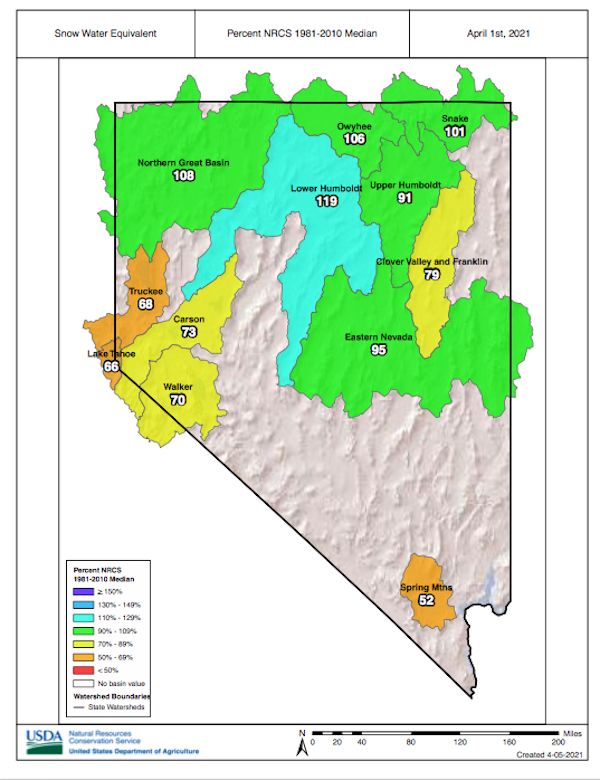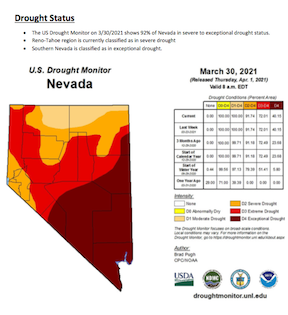Lahontan Valley producers are busy preparing the land for crops, but they could be facing adjustments in water allocations next month.
Photo by Steve Ranson.
The latest snow measurements from last week’s SNOTEL (Snow Telemetry) readings for Northern Nevada are not painting a rosy picture for both the spring and summer months, said Jeff Anderson, a hydrologist for the Natural Resources Conservation Service.
Anderson said the Truckee Basin is 69% of median, while the Carson Basin is at 73% and represents no change from the March reading. The Tahoe Basin is at 66%, and the Walker Basin reported in with 70%. According to the various SNOTEL readings across the region, Anderson said the Humboldt Basin is in better shape with 97% of average.
“It’s looking bleak right now,” Anderson said of the readings in western Nevada. “We certainly didn’t get the March we had last year.”
Northern Nevada faced a similar situation in 2020, but a series of storms pounded the area to give an ample supply of water for both farmers and recreationists.
“We were below average last year, but the snow helped boost the streamflow,” he added.
Rusty Jardine, general manager of the Truckee-Carson Irrigation District, said in March the water allocation for the Lahontan Valley was at 90% from the Carson Division and 100% from the Truckee, which feeds into the Fernley area and then flows into the Lahontan Reservoir. Jardine said TCID’s board of directors will re-examine water allocations at their May meeting, and they could be looking at allocations dropping to 85% in the Carson and 93% for the Truckee.
 “We may look at adjustments,” he said.
“We may look at adjustments,” he said.
The Lahontan Reservoir’s level at this time of year is the lowest since 2016 when the area endured a drought of similar proportions. The reading on Sunday came in at 121,195 acre-feet, the lowest level since 90,665 acre-feet was recorded five years ago. The Lahontan Reservoir’s capacity is 308,000 acre-feet with each acre-foot representing about 326,000 gallons or enough water to cover an acre of land at one-foot deep.
In March, Anderson said the totals represented the 15th lowest snowpack out of the past 41 years. Looking at the precipitation since 1981, he said the Truckee Basin’s average of 55% is the fifth lowest in 40 years, and the Carson Basin at 62% is the ninth lowest. Anderson said the lowest 18-month precipitation was from Oct. 1, 1986 to April 1, 1988.
“The (current) 18-month precipitation total ranks second lowest since 1981 for most SNOTELs in the eastern Sierra,” Anderson pointed out.
The water year to date for precipitation is from Oct. 1, 2020 to April 1. Anderson said the U.S. Drought Monitor shows 92% of the Silver State is in severe to exceptional drought conditions. Most of Churchill and Mineral counties and western Pershing County are in an extreme drought status. Southern Washoe County and most of Carson City and Storey, Lyon and Douglas counties are in severe drought as is the northern tier of the state. On the other hand, most of Southern Nevada extending toward eastern White Pine and Elko counties are in the exceptional drought status.
Anderson said the U.S. Drought Monitor shows 92% of the Silver State is in severe to exceptional drought conditions. Most of Churchill and Mineral counties and western Pershing County are in an extreme drought status. Southern Washoe County and most of Carson City and Storey, Lyon and Douglas counties are in severe drought as is the northern tier of the state. On the other hand, most of Southern Nevada extending toward eastern White Pine and Elko counties are in the exceptional drought status.
Anderson said he has concerns for the next winter if the area doesn’t receive ample precipitation. Currently, the reservoirs have enough storage to meet the demands through most of the summer. Based on records, though, he said the chances are good the lower Carson River could dry up sometime during the late summer. Anderson said the Carson River at Fort Churchill is forecast at 26% of average from now to July. Although the Humboldt Basin is showing good numbers, Anderson said the snowpack flows into the rivers and streams don’t look good. He also said the Ruby Mountain range is similar to the Sierra Nevada in facing low measurements.
“Soil moisture under the snowpack has been very dry since last fall,” Anderson said. “Dry soil acts as a sponge as the snow begins to melt. The soil profile needs to fill before runoff is most efficient, and this will likely reduce the amount of snowmelt that reaches our rivers and reservoirs.”


Comments
Use the comment form below to begin a discussion about this content.
Sign in to comment